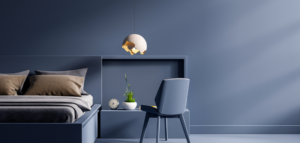Reviving Retro: Nostalgia and Vintage Design in Modern Interiors

In the ever-evolving domain of interior design, the past is making a comeback. Vintage and retro design elements, once considered outdated, are now experiencing a resurgence in contemporary interiors. From mid-century modern furnishings to art deco accents, the allure of nostalgia is undeniable. This article will delve into the reasons behind the revival of retro design and explore how an interior design course can provide valuable insights into seamlessly blending old and new styles.
The Allure of Nostalgia
Nostalgia is a powerful emotion. It tugs at heartstrings, reminding people of simpler times and cherished memories. This emotional connection is precisely what makes vintage and retro design so appealing. It allows them to relive the past while infusing their modern lives with a touch of history.
Embracing Mid-Century Modern
One of the most iconic styles making a comeback is mid-century modern. Characterized by clean lines, sleek furniture, and a minimalist approach, this design era, which emerged in the mid-20th century, has left an indelible mark. Today, mid-century modern pieces like Eames chairs and Scandinavian furniture are highly sought after, adding a timeless elegance to contemporary interiors.
Rediscovering Art Deco Glamour
Art Deco, with its opulent materials and geometric patterns, is another retro style gaining prominence in modern interiors. From gilded mirrors to bold, symmetrical designs, Art Deco brings an air of luxury and sophistication to spaces. It’s not just about recreating the past; it’s about elevating the present.
Art Deco, which originated in the 1920s and 1930s, is synonymous with lavish living. The use of sumptuous materials like brass, chrome, glass, and exotic woods is a hallmark of this style. It celebrates modernity through its fusion of geometric shapes and intricate detailing, making it a perfect fit for contemporary interiors seeking a touch of glamor.
One of the most appealing aspects of Art Deco is its versatility. It can seamlessly blend with various design aesthetics, from industrial chic to minimalist modernism. Incorporating Art Deco elements into your interior can be as subtle as adding a few statement pieces or as bold as redesigning an entire room around the style.
The Sustainability Factor
The resurgence of vintage and retro design is not merely about aesthetics; it’s also about sustainability. In an age where eco-consciousness is paramount, choosing pre-owned or upcycled furniture is a responsible choice. Repurposing and restoring vintage pieces not only reduces waste but also contributes to the unique character of a space.
Upcycling and Repurposing
Upcycling involves giving old items a new lease on life. Interior designers and enthusiasts are increasingly drawn to the idea of repurposing vintage finds. An antique dresser can become a stylish bathroom vanity, while reclaimed wood from a barn can transform into a rustic dining table. These creative solutions not only reduce the environmental impact but also result in truly one-of-a-kind interiors.
Interior Design Courses
While the idea of incorporating vintage elements into modern interiors may sound appealing, it’s not always easy to strike the right balance. This is where interior design courses can be invaluable. They offer insights into the art of blending old and new styles seamlessly.
Understanding Design History
An interior design course will often include modules on design history. Studying the evolution of design styles and their historical contexts equips aspiring designers with the knowledge needed to make informed choices when mixing retro elements with contemporary ones.
Developing an Eye for Detail
Interior design is all about the details. Courses teach students how to identify key features of vintage pieces and recognize their compatibility with modern designs. This skill is crucial when sourcing and curating a cohesive collection of furnishings and décor.
Creating Harmonious Spaces
The true magic of interior design lies in creating harmonious spaces that reflect the homeowner’s personality and style. These courses delve into the principles of balance, proportion, and color theory. These fundamentals guide designers in achieving a cohesive look when merging old and new elements.
Conclusion
The revival of vintage and retro design elements in modern interiors is more than just a trend; it’s a reflection of the deep-seated love for nostalgia and sustainability. As people welcome the charm of mid-century modern and the opulence of Art Deco back into their homes, they are also making conscious choices to reduce their environmental footprint through upcycling and repurposing.
For those looking to embark on the journey of blending old and new styles seamlessly, professional courses provide invaluable insights. By understanding design history, honing an eye for detail, and mastering the art of creating harmonious spaces, aspiring designers can navigate the past and present to craft interiors that are both timeless and unique. So, as you embark on your design adventure, remember that nostalgia is not just a feeling but a design choice that brings depth, character, and soul to your modern abode.







